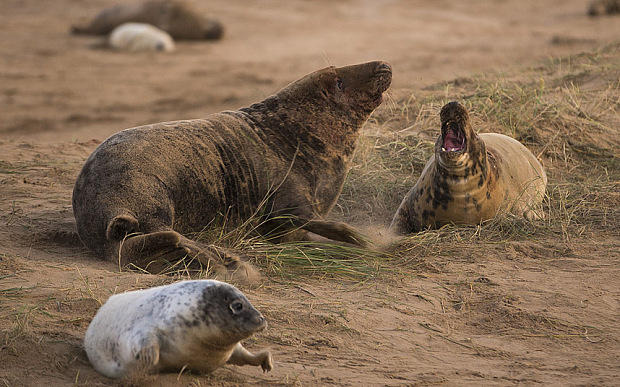
Grey Seal bulls fight at sunset near the Lincolnshire Wildlife Trust's Donna Nook nature reserve in Grimsby
Grey seals may be a danger to swimmers after scientists discovered they were responsible for the widespread slaughter and mutilation of North Sea porpoises.
Wildlife experts have long been divided over what caused the horrific injuries seen on the bodies of hundreds of beached harbour porpoises. Some blamed boat propellers while others claimed the animals had become entangled in fishing nets and left at the mercy of scavengers.
Now DNA analysis of their injuries has led to an intriguing conclusion. It seems they are regularly attacked and killed by grey seals which tear strips of nutritious blubber from their bodies.
And scientists have warned that the seals could target human swimmers in a similar way.
Over the past decade more than one thousand severely scarred and wounded porpoises have washed up on North Sea coastlines.
"A substantial proportion of harbour porpoises that stranded on the Dutch coast were mutilated by grey seals," said lead researcher Mardik Leopold of the Institute for Marine Resources and Ecosystem Studies in The Netherlands.
"Most cases involved active killing and that only a small proportion can be attributed to post-mortem scavenging. This makes predation by grey seals one of the main causes of death in harbour porpoises currently stranding in The Netherlands.
"Many of the mutilated porpoises were found on Dutch shores used frequently by human bathers and surfers and there would appear to be no reason why humans may not be at risk from grey seal attacks."
Grey seals can grow to nearly 11ft in length and weigh 880lbs. There are large colonies in UK waters including at Donna Nook in Lincolnshire, the Farne Islands off the Northumberland coast, Ramsey Island off the coast of Pembrokeshire as well as large populations on the Scottish islands of Orkney and North Rona.
Although only a few mutilated porpoises have ever washed up onto British shores, experts say it could be just a matter of time before the behaviour becomes widespread, and pose a real danger to humans.
"Very few have been found, and recognised for what they are, in the UK," added Mr Leopold.
"Yet, most grey seals live in Scotland, and so do many porpoises, and we know that grey seals sometimes swim from the UK to the Continent.
"It could be just a matter of time, of course as this behaviour is now very common here."
Researchers looked back at images of 1,081 dead porpoises which washed up between 2003 and 2013. Of the 721 animals which were fresh enough to look for marks, some 25 per cent showed visible signs of attack by grey seals. They were also compared to three porpoises which had seal DNA in their wounds. The bites and scratches were found to match.
The scientists estimate that at least 17 per cent of animals washed up on shore were killed by the seals adding that many more bodies are likely to have been lost at sea or eaten completely.
Richard Harrington, of the Marine Conservation Society said: "Grey seals can be very territorial and we would always tell people not to approach them. Scuba divers often report being approached by seals.
"I have never heard of any attacks on bathers but you can't rule it out.
"We have had lots of reports of carcasses of harbour porpoises where we have been unable to explain their deaths or their condition and this report gives a feasible explanation."
The authors suggest that grey seals may have originally scavenged the bodies of porpoises which had become entangled in fishing nets and drowned, before moving to actually hunting the animals.
A spokesman for the RSPCA said swimmers should take care when in the water near seals.
"While we would urge people not to be unduly concerned by this study, it is important for people to remember that seals are wild animals and are therefore by their nature unpredictable.
"We would advise members of the public to be cautious around them however its unlikely these animals would pose an immediate threat to humans in the sea.
"Generally, seals do not directly interact with people and are naturally wary of humans. Like many other members of British wildlife they shun human contact.
"If a member of the public find a seal in distress we would urge them to contact rescue organisations such as ourselves where trained handlers can respond."
The research was published in the journal Proceedings of the Royal Society B.



Reader Comments
to our Newsletter